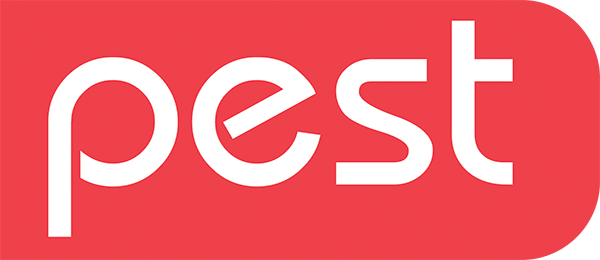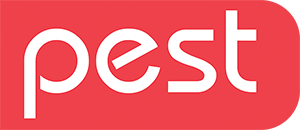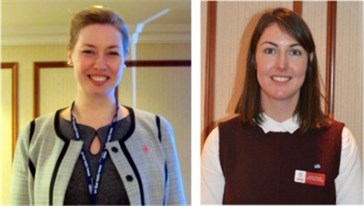Once again this years PestTech offered a range of technical presentations, from the latest updates on slow burning long term issues, to the new and novel. All of the presentations were packed to the doors!
The new system of scanning bar-coded badges as delegates entered the room certainly speeded up the collection of CPD points and was a big improvement on the previous year when the manual system caused long delays. Allowing more time for the changeover of speakers also helped the seminar programme run much more smoothly.
| First up were Mike Palmer-Day and Nigel Sargent from ServiceTracker, who both have a history of working at a practical level in pest control, as well as within the IT industry. They described their software as designed for pest controllers by pest controllers.
In their presentation they identified the top seven management and admin type problems encountered by a growing pest control business and the benefits of using an integrated system, in particular the ServiceTracker. With the likes of sales management, job scheduling, route mapping, invoicing and financial analysis all brought together, the presentation closed with an explanation of the top solutions offered by the system. Lunchtime sessions also full Amy is now a qualified pest professional with Brian Kelly Environmental Services in Northern Ireland. Before that, however, she was a website developer and marketing consultant, working at various times in Silicon Valley, New York, Florida and Texas. She still runs a web consutancy in the USA. In her presentation she shared some trade secrets but the main take home message was simple. Get your business on the Google Map and don’t be frightened of the technology, it’s all pretty easy to do yourself. The queue to get out of the Google Maps session ground to a halt when it met the queue to get into the following talk. |
|
|
| That was on CEPA Certified and EN 16636 – The Standard for Professional Pest Management by Jessica Morgan from Bureau Veritas UK. Read more in Pest issue 47: October & November 2016. CEPA Certified is a standardisation scheme for pest management businesses across Europe, launched in 2015. Prospective companies seeking certification in the UK are assessed and audited by Bureau Veritas. To date 57 UK pest management businesses have achieved registration from some 250 across Europe. Jessica described the process leading to certification and, drawing on examples, the benefits of certification. Once achieved certification is valid for three years after which continuation is secured by means of an audit.
Rodenticide Stewardship – what next? The structure of CRRU has been adapted from the familiar ‘user type’ basis (farmers, pest controllers, distributors etc.) to a more ‘functional’ arrangement (‘best practice’, regulatory, monitoring etc.) to implement stewardship. Targets have been set to demonstrate the progress of stewardship to the ‘Government Oversight’ group. Since last year’s update a number of significant developments have occurred, perhaps the major of which is ‘Brexit’. Dr Buckle expressed the opinion that because the Stewardship Regime is driven by the Health and Safety Executive (HSE), Brexit would not change either the impetus or direction. However, the European Chemicals Agency’s (ECHA) re-classification of anticoagulants as ‘toxic to reproduction’ will have an impact as this is likely to prove a game changer as to the nature of products available and who can use them. This reclassification of anticoagulant rodenticides was outlined at the Pest Control News (PCN) workshop by Dr Matt Davies, Killgerm technical adviser and techncial editor for PCN. In summary any product with an active substance concentration of 30 parts per million or more will be reclassified as ‘toxic to reproduction’. No product classed this way can be sold to amateurs and professional use products will have to carry ‘an exploding heart warning symbol’ and the words ‘May harm the unborn child‘ on their labels. Currently all professional products (except for those containing difethialone) have concentrations above this limit. There is an 18 month transition period meaning the reclassification will come into force at the end of 2017. The concern is that customers may not want products classified in this way on their premises. Read more in Pest issue 43 February & March 2016. The logistical problem of how to steward farmers has been dealt with by a policy decision, made by CRRU and supported by HSE, to bring about change by working through the farm assurance schemes rather than by insisting on certification. Updated industry codes for bees and glueboards Iain explained how the Alliance has worked for the last four years on Rodenticide Stewardship and will continue to do so as the focus shifts towards monitoring. The Alliance has also worked on two other long term issues, the defence of the continued use of rodent glueboards and action taken against feral bee colonies. In both cases Codes of Best Practice have been developed and, over the years, refined to meet changing perceptions. The latest versions will be published on the Pest Management Alliance website later this month. Bird control using lasers The lasers used are low power, so as not to pose a risk to pilots. Nevertheless they have a range of up to 2km at night, reducing to about 1km in bright sunshine. The system works by projecting a ‘green dot’ moving towards flocks of grazing birds. The effect is to drive all of the birds into the air. The system works with a wide variety of species with the exception of raptors, which do not present a major problem anyway. Steiner also reported that there appears to be no issue with habituation. The Agrilaser Autonomic laser bird dispersal system from the Bird Control Group was voted best new product 2016 by Pest readers. |
||



 Amy Kelly (left) and Jessica Morgan
Amy Kelly (left) and Jessica Morgan